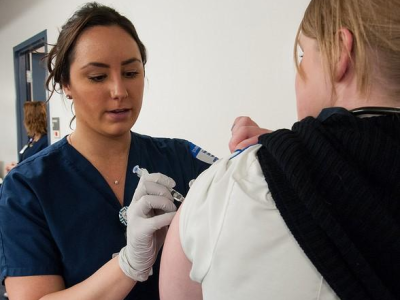Estimates of current mid-season flu vaccine effectiveness (VE) in Europe and China range from 32% to 58% overall, with greater protection against influenza B than A, according to three studies published in Eurosurveillance.
32% to 58% protection in Europe
In Europe, the 2009 H1N1 influenza A strain is the predominant flu virus and is circulating along with influenza A(H3N2) and B/Victoria.
Public health researchers who analyzed eight test-negative studies from 17 European countries (five single- and three multi-country) estimated an interim all-age influenza A VE of 32% to 53% in primary care from September 2024 to January 2025. In this setting, it was least effective among children and adults aged 65 years and older.
In hospitals, VE was 33% to 56%, with some signals of lower VE by subtype and higher VE against influenza B (58% or higher in both settings).
In summary, flu vaccination prevented one third to more than three quarters of infections in primary care or hospitals, but protection varied by age-group and study. The vaccine protected a third to over a half of participants against influenza A infection, the main circulating subtype.
The authors recommended continuing to promote vaccination among target groups and strengthening other prevention measures for older adults. They called for end-of-season studies with larger sample sizes and more information on virus characteristics that may help explain variations in effectiveness.
42% efficacy in France
Researchers in France, who reported high levels of flu circulation in Europe starting in November 2024, conducted a test-negative study using data on 44,420 flu-negative and 15,052 flu-positive people from more than 1,600 French community labs from October 2024 to February 2025.
Preliminary findings for the 2024/25 influenza season highlight the continued value of vaccination in reducing influenza burden, with effectiveness varying by virus type and age group.
Overall VE for all age-groups was 42%, with 26% against influenza A and 75% against influenza B. Estimated VE was 60% among people aged 0 to 64 years, falling to 22% among those aged 65 and older. VE among symptomatic participants was 41% both for those who had respiratory symptoms and those who had a fever.
Flu vaccine uptake among participants was 6.5% in adults aged 18 to 64 years and 36% in those 65 and older, rising in the overall population from 1.8% in week 44 to 19% in week 52 in 2024 and up to 52% in older adults.
"Preliminary findings for the 2024/25 influenza season highlight the continued value of vaccination in reducing influenza burden, with effectiveness varying by virus type and age group," the study authors concluded. "Strengthened public health efforts to increase vaccine uptake and potentially to improve vaccine formulations remain critical to reducing the impact of seasonal influenza."
China reports 49% effectiveness
Chinese researchers used a test-negative study design to estimate VE among non-hospitalized patients in Beijing, where H1N1 predominated (99.3%), with all 38 sequenced strains clustered in clade 6B.1A.5a.2a and 37 of 38 antigenically similar to the vaccine strain. The study was based on data from the Influenza Surveillance System in Beijing, which includes 40 sentinel hospitals and 19 network labs, from October 2024 to January 2025.
Our study found a moderate VE (48.5%) against medically attended laboratory-confirmed influenza, similar to the interim finding of Canada (53%).
A total of 8,775 patients with influenza-like illness were recruited, with 76.8% testing negative for flu and 23.2% testing positive. VE against infection with any flu virus was 48.5%, while it was 48.7% against H1N1. Vaccination in the current or previous season against any flu virus was 52.5% to 54.9% effective, respectively, compared with no vaccination in both seasons.
"Our study found a moderate VE (48.5%) against medically attended laboratory-confirmed influenza, similar to the interim finding of Canada (53%)," the authors wrote. "In comparison, VE in Beijing was below 45% in the previous three seasons, while in Europe, it ranged from 30% to 53%, and in the United States, it varied between 19% and 48% over the past 10 seasons."
They noted that early estimates of flu VE are crucial for formulating flu-prevention strategies and supporting World Health Organization (WHO) vaccine strain recommendations.
Last week the WHO announced its advisory committee's recommendations on the strains to include for the Northern Hemisphere's 2025-26 flu season, which change the H3N2 components but keep the current 2009 H1N1 and influenza B strains the same.
The three strains recommended for the trivalent (three-strain) vaccine are also the same as those recommended for the Southern Hemisphere's 2025 season vaccine, which the group weighed in on at its meetings in September 2024.



















